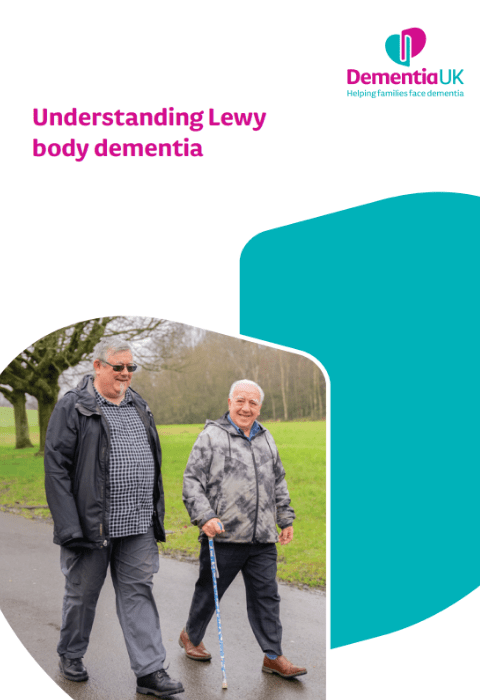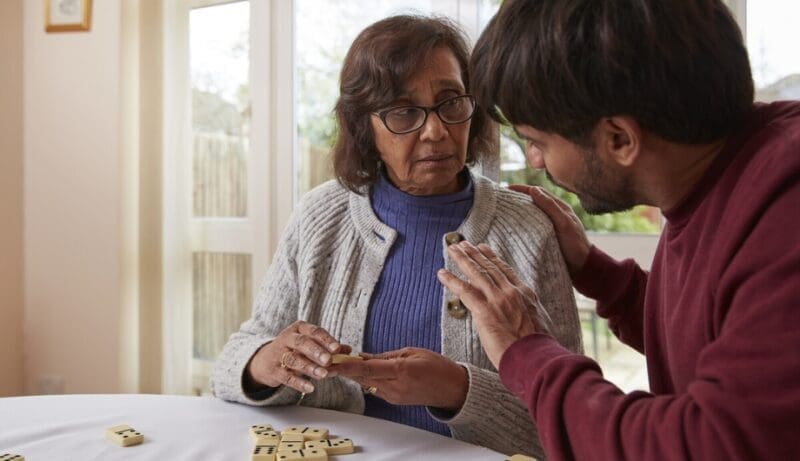
Tracy’s story
Tracy's husband Steve has Lewy body dementia, Tracy talks about support they've received from Admiral Nurse Liz.
Lewy body dementia is an overarching term for a set of complex and challenging conditions that can be mistaken for Alzheimer’s disease due to the overlap in symptoms. This means it may be misdiagnosed. However, getting an accurate diagnosis as early as possible will enable the right support to be put in place to help manage its progression and maintain the person’s quality of life.
Our dementia specialist Admiral Nurses explain what Lewy body dementia is, its subtypes and how to manage the condition.
Lewy bodies are abnormal clumps of protein that develop in nerve cells in the brain. The reasons for this are not yet fully understood, although research is ongoing.
Lewy bodies affect the normal functioning of brain cells. They can build up in any part of the brain but are most common in the areas responsible for thought, movement, visual perception, sleep and alertness.
Lewy body dementia is an umbrella term for two different types of dementia: dementia with Lewy bodies and Parkinson’s dementia. The main difference between the two types of Lewy body dementia is when specific symptoms first occur. In dementia with Lewy bodies, usually cognitive changes will happen first, while in Parkinson’s dementia, usually physical changes will happen first.
Lewy bodies are present in people who have Parkinson’s, usually in the areas of the brain responsible for movement. Not everyone with Parkinson’s will develop dementia, but about one third will, with the risk increasing the longer people live with the condition.
Dementia with Lewy bodies is caused by a build-up of Lewy bodies in the areas of the brain that control alertness, visual perception and thinking. This interrupts the connections between brain cells and can eventually stop them from working. It also reduces the chemicals that are needed in the brain to function properly.
In the early stages, Lewy body dementia is often mistaken for Alzheimer’s disease, as some of the symptoms are similar – for example, problems with thinking and perception. However, it differs from Alzheimer’s disease in that it can particularly affect the person’s movement (Parkinsonism), and can cause hallucinations, delusions, and changes in alertness.
The symptoms of dementia with Lewy bodies are complex and may differ depending on whether a person has dementia with Lewy bodies or Parkinson’s dementia. Not everyone will experience all the symptoms or develop them at the same time.
In dementia with Lewy bodies, cognitive changes usually happen first. These can include:
These symptoms tend to occur at least one year before, or at the same time as, the person develops problems with movement.
In Parkinson’s dementia, physical changes happen first. These include difficulties with movement (Parkinsonism) such as tremors, rigidity or slowness. Other problems may include sleep disturbance, dizziness and poor balance, changes in bowel or bladder function, difficulty regulating body temperature and a loss of sense of smell. These symptoms usually develop one year or more before cognitive changes become apparent.
A person with dementia with Lewy bodies may experience changes in their mental function, including:
Memory problems are often less common in the early stages than in some other forms of dementia.
Dementia with Lewy bodies may cause changes in behaviour such as sudden changes and fluctuations in alertness – people may stare blankly into space for periods of time, seem drowsy and lethargic and spend a lot of time sleeping. As the condition progresses, some people experience periods of unresponsiveness.
Physical symptoms tend to be more pronounced in Parkinson’s dementia than Lewy body dementia, particularly in the early stages. They include movement problems such as:
Other physical symptoms can include (although will not be experienced by everyone):
Psychological symptoms often occur in dementia with Lewy bodies and may include:
Dementia with Lewy bodies accounts for 10-15% of diagnoses of dementia, although some studies suggest it may be up to 20%. Around 10% of people with young onset dementia (where symptoms develop before the age of 65) have Lewy body dementia.
Getting an accurate diagnosis of Lewy body dementia is important to ensure the person receives the right treatment and support. This process begins with seeing the GP. If they believe the person is showing signs of Lewy body dementia, they should refer them to a memory clinic or dementia service and/or a movement disorder/Parkinson’s service. This may depend on which symptoms appear first.
The diagnostic process includes taking a family and medical history, asking the person (and a family member or other person close to them, if possible) about their symptoms, and assessing their physical health. The person carrying out the assessment should ask about:
Basic cognitive tests may be carried out to check the person’s visual/spatial abilities and memory, alongside an assessment of motor (physical) function, eg tremors, problems with gait (how the person walks) and rigidity.
If the diagnosis is not clear following specialist assessment, a specific scan may be required to measure levels of the chemical dopamine, which are usually low in people with Lewy body dementia. This is called a SPECT scan or DaTSCAN. It involves having an injection of a special radioactive substance, usually into a vein in the arm, which helps show how much dopamine is being transported in the brain. The dose of radiation is very small and is quickly eliminated from the body.
Investigations for other symptoms of Lewy body dementia may include:
Lewy body dementia can be difficult to diagnose in the early stages because its symptoms often overlap with Alzheimer’s disease or psychosis (a psychological condition where the person sees, hears or believes things that are not real). Many cases are initially misdiagnosed or overlooked because of this, but as more symptoms develop, such as visual hallucinations, movement problems or sleep disturbances, doctors can usually identify Lewy body dementia more accurately.
If you think the person has been misdiagnosed or their condition has changed, ask the GP to make a referral for further assessment. This may be with a neurologist for motor symptoms or a dementia specialist for cognitive or psychological symptoms.
People with Lewy body dementia may be offered medication, alongside other treatments, to help with their symptoms. These will not stop or reverse the progression of the condition but may improve quality of life for them and their families and carers.
Some of the medications used to treat Alzheimer’s disease may help with the cognitive symptoms of Lewy body dementia, for example, by reducing distressing hallucinations and improving concentration and memory problems. These are usually most effective in the early to middle stages, but do not help everyone.
It is important to know that many people with Lewy body dementia are particularly sensitive to medications known as antipsychotics, which are sometimes used to treat hallucinations. Only certain types, known as atypical antipsychotics, should be used, and even then, with extreme caution.
Medications used for Parkinson’s may be helpful, but again, caution is required as certain medications or higher doses may make hallucinations worse.
If you have any concerns about the introduction of a new medication or change in treatment or notice any side effects, discuss this with the person’s GP or specialist as soon as possible.
Other treatments focus on symptom control and are detailed below.
Physiotherapy can help with managing some of the symptoms of Lewy body dementia. Exercises to strengthen the leg muscles can improve posture and coordination and teach the person safer movement strategies. Stretching and gentle aerobic exercise can also help reduce pain from muscle stiffness.
Music and art therapy can help to improve mood, reduce agitation and enhance communication. Music in particular is known to stimulate memory while songs with a steady beat can improve gait and reduce freezing episodes. Read more about music and dementia.
Activities designed to exercise and improve specific cognitive functions like memory and problem-solving can help slow the decline in a person’s cognitive abilities. This is sometimes referred to as cognitive stimulation therapy. These activities include puzzles, memory games and computer-based programs. Word games and sorting tasks can also help reduce apathy and provide a sense of accomplishment.
It is hard to predict how quickly Lewy body dementia will progress, and each person will have their own experience, so it is better to focus on maintaining quality of life and enjoying time together than on how quickly they will deteriorate. However, it is generally considered to progress in three stages.
In the early stages of Lewy body dementia, people can often manage simple tasks but may struggle with complex activities such as finances and driving. They may experience disturbances in their perception and can misinterpret things, sometimes leading to visual hallucinations, but often retain insight into what is happening. Fluctuations in awareness or thinking are common, and people may appear to have lost focus or concentration. Up to 90% of people with Lewy body dementia are found to have experienced sleep disturbances before their diagnosis.
In the middle stages of Lewy body dementia, the person will usually need more assistance with things such as dressing, bathing and preparing meals. They may have difficulty recognising familiar places or people and may need supervision because of the risk of falls and hallucinations. The person may struggle with communication and experience increasing anxiety, low mood and fluctuations in awareness or concentration.
In the later stages of Lewy body dementia, a person experiences an increasing decline in cognitive and physical abilities. They are likely to have difficulty with verbal communication and may become unable to recognise their surroundings or loved ones. The person may eventually be unable to leave their bed and require full-time care. They may still experience hallucinations, even if they cannot express that this is happening. They may also experience difficulties swallowing and be susceptible to infections.
The progression of Lewy body dementia can vary significantly from person to person. Over time, most people will need support at home, and some may eventually need to move into a nursing home.
With support, a person with Lewy body dementia can maintain their quality of life for as long as possible. Strategies that may help include:
Meaningful activities can help a person with Lewy body dementia maintain their independence, quality of life, self-esteem and social connections. You can encourage them to continue with their usual routines and activities, such as work, everyday tasks (with support if necessary), spending time with family and friends, hobbies and travel.
The person may also like to try new activities to maintain their motor and cognitive function, for example joining a community group such as a choir or book club, learning a skill like a language or craft, trying a new sport or physical activity that suits their level of ability, or joining support groups for people in similar situations.
Bear in mind that everyone with dementia will have their own strengths and abilities, and their usual activities will need to adapt as their condition progresses. However, with support, the person can live as well as possible with Lewy body dementia, for as long as possible.
For more information visit lewybody.org. You can also phone our free Dementia Helpline to speak to a dementia specialist Admiral Nurse about Lewy body dementia on 0800 888 6678 (Monday-Friday 9am-9pm, Saturday and Sunday 9am-5pm), email helpline@dementiauk.org or you can pre-book an appointment by phone or video call with an Admiral Nurse.
Lewy body dementia is an umbrella term for two different types of dementia: dementia with Lewy bodies and Parkinson’s dementia. Read more in this leaflet.


Tracy's husband Steve has Lewy body dementia, Tracy talks about support they've received from Admiral Nurse Liz.

Rob's shares his story of partner Jayne, who experienced behavioural changes after a car accident and was diagnosed with dementia at the age of 59.

People with Lewy body dementia often get misdiagnosed with Alzheimer’s disease – let’s change that together. Donate today.
Lewy body dementia is often misdiagnosed because its early symptoms are similar to Alzheimer’s disease or other types of dementia. It can also be mistaken for delirium: a state of sudden confusion that often develops as a result of an infection.
If someone has Lewy body dementia, getting the correct diagnosis is important to ensure they receive the right treatment and management. If you think the person has been misdiagnosed or their condition has changed, ask the GP to refer them for further assessment. This may be with a neurologist for physical symptoms or a specialist dementia service such as a memory clinic for cognitive or psychological symptoms.
Lewy body dementia and Alzheimer’s disease are both types of dementia, but affect different functions of the brain and have distinct differences in their symptoms and progression.
Lewy body dementia is distinguished by its early visual hallucinations, fluctuations in cognitive abilities and physical symptoms, while Alzheimer’s disease is primarily characterised by progressive memory loss and cognitive decline. Lewy body dementia also often progresses more rapidly than Alzheimer’s.
Some people have mixed dementia involving Lewy body dementia: for example Alzheimer’s disease with Lewy body dementia or vascular dementia with Lewy body dementia. Mixed dementia may progress faster than in people with just one form of dementia.
There’s currently no cure for Lewy body dementia, but there are therapies and strategies that can help manage the symptoms, including medication for some people.
While symptoms of Lewy body dementia tend to develop gradually and progress slowly over the course of several years, some people can experience sudden and dramatic swings between alertness and confusion or sleepiness – this may happen unexpectedly and change over minutes or hours.
Some people in the early to middle stages of Lewy body dementia may be able to live alone and independently for some time. However, the progressive nature of the condition means that they will need increasing levels of supervision and support as their physical and cognitive abilities decline, which may mean moving into a care home.
When someone is diagnosed with dementia of any type, legally, they must inform the Driver and Vehicle Licensing Agency (DVLA) in England, or the Driver and Vehicle Agency (DVA) in Northern Ireland. But while it is possible that the person may be told to stop driving, many people in the early stages of dementia are able to continue for some time.
With Lewy body dementia, it is particularly important to be aware that visual hallucinations or difficulties with perception may make driving challenging, even in the early stages. Read more about driving and dementia.